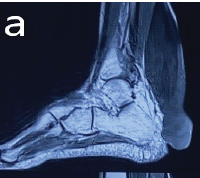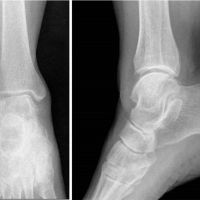Synovial chondromatosis needs complete excision for better prognosis.
Dr. Rajlaxmi Reddy, Department of Orthopaedics,Sree Balaji Medical College, Chennai - 600044, India. E-mail: saiprasadend@gmail.com
Introduction: Synovial chondromatosis is a rare non- malignant bone tumor. Most commonly middle aged people are affected . This condition most commonly occurs in knee joints, and rarely, it may occur in other joints. Patient usually complaints of pain, swelling and restrictions of movements at the affected joint. Diagnosis is made through thorough clinical examination and Radiological investigation. Condition is treated with open synovectomy with the removal of loose bodies. If not treated in time the patient might develop early osteoarthritic changes and rarely develop into malignancy in few cases.
Case Report: A 43 year old female came with complaints of pain and stiffness over the right elbow which aggravates on movements without alleged history of trauma. The patient was diagnosed with synovial chondromatosis after appropriate radiological investigation. The patient underwent open synovectomy and post operatively adequate physiotherapy was initiated at the operated elbow. After 6 months of follow-up, the patient improved clinically and functionally.
Conclusion: Synovial chondromatosis of the elbow is a rare benign orthopedic condition that appears as multiple hyaline cartilage nodules within sub synovial connective tissue. Complete excision of synovium is necessary to prevent the recurrence and for better clinical outcome
Keywords: Synovial chondromatosis of the elbow , benign tumor , synovectomy
Synovial chondromatosis is a rare type of non- malignant bone tumor that grows outside the bone[1,2]. Most people have multiple nodules or tumors in a single joint. The most common place for nodules to form is knee. Nodules may also affect elbow, hip, or shoulder , rarely it may also affect smaller joints such as ankle, wrist, or jaw[3,4,5]. The clinical features are difficulty in movements at affected joint associated with gritty sensation[6,7,8]. The treatment of choice is synovectomy and removal of loose bodies.
A 43 year old female presented with chief complaints of pain over her right elbow for the past 8 months along with stiffness over the elbow joint. The pain was Insidious in onset, gradual in progression, aggravated on movements. There is no history of trauma, any medical comorbidities, previous surgeries and any significant family history. On examination a diffuse swelling was present around the elbow joint, Tenderness is present over the medial joint line, Range of movements was restricted due to stiffness and pain. There is no distal neurological deficit. X-ray right elbow (Fig. 1a and b) and magnetic resonance imaging were taken (Fig. 2a and b) and the diagnosis was confirmed as synovial chondromatosis of the right elbow. 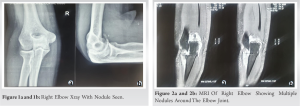 She was planned for open synovectomy with the removal of loose bodies because it is cheaper than arthroscopic procedure. Through the medial parapatellar approach, a plane of cleavage was created with deep dissection and thickened synovium with loose bodies was removed (Fig. 3), and histopathology report showed nodules of metaplastic cartilage and classified as stage 3 with multiple free osteochondral bodies.
She was planned for open synovectomy with the removal of loose bodies because it is cheaper than arthroscopic procedure. Through the medial parapatellar approach, a plane of cleavage was created with deep dissection and thickened synovium with loose bodies was removed (Fig. 3), and histopathology report showed nodules of metaplastic cartilage and classified as stage 3 with multiple free osteochondral bodies.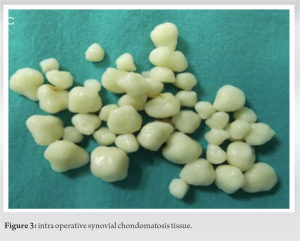 Post – operatively patient is treated with medications and physiotherapy at the elbow joint. Regular dressing were done, and the patient was said to continue the physiotherapy for 6 months and asked for serial follow-up (Fig. 4).
Post – operatively patient is treated with medications and physiotherapy at the elbow joint. Regular dressing were done, and the patient was said to continue the physiotherapy for 6 months and asked for serial follow-up (Fig. 4).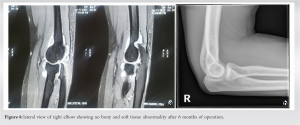 On follow-up, the patient has improved movements at the elbow joint without pain (Fig. 5a and b).
On follow-up, the patient has improved movements at the elbow joint without pain (Fig. 5a and b).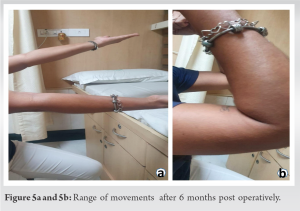
Treatment of synovial chondromatosis of the elbow is important to improve the symptoms and range of movements[9,10,11]. Most of this condition is benign and rarely changes into malignancy, so it should be operated as early as possible to avoid early osteoarthritis of an affected joint. Diagnosis is made clinically and radiologically[5,12,13]. This condition is most commonly seen in middle-aged group. This study is done in such a way that all the patients with synovial chondromatosis treated with synovectomy were improved symptomatically post- operatively with significant improvement in a range of movements[3, 5, 6, 8, 14].
Follow up:
Patient was followed upto 18 months and last follow-up, was May 2022. During every follow- up patient has no c/o difficulty in range of movements.
Results:
Postoperatively patient’s clinical and functional outcome was good, and radiographically, no recurrence was present due to complete excision.
Synovial osteochondromatosis of the elbow joint is a uncommon begnin condition usually presents as multiple nodules of hyaline cartilage within the subsynovial connective tissue. The exact is not known. It is usually monoarticular and mostly involves knee joint to lesser extent; it may also involve the elbow, shoulder, hip joint and rarely the small joints. Clinical features of Synovial chondromatosis are pain, swelling, loss of motion, and stiffness, and on examination swelling , restriction of movements, and tenderness. The management is the removal of synovium with dead tissue. The purpose of treatment is to improve the symptoms and the range of movements. The prognosis is good and recurrence rate is low if synovium is completely removed. If not removed completely, the failure rate is high and patient compliance will be poor.
Synovial chondromatosis is benign condition which needs to be removed completely either through open or arthroscopic procedure depending on its location and surgeon’s preference for the prevention of recurrence and malignant transformation.
References
- 1.Giannetti S, Santucci A, Patricola A, Stancati a, Di Sanzo V. Neglected synovial osteochondromatosis of the elbow: a rare case. World J Surg Oncol. 2013; 11: 233. [Google Scholar]
- 2.Kamineni S, O’Driscoll SW, Morrey BF. Synovial osteochondromatosis of the elbow. J Bone Joint Surg Br 2002;84:961–6. [Google Scholar]
- 3.Narasimhan R, Kennedy S, Tewari S, et al. Synovial chondromatosis of the elbow in a child. Indian J Orthop 2011;45:181–4. [Google Scholar]
- 4.Giustra PE, Furman RS, Roberts L, et al. Synovial osteochondromatosis involving the elbow. AJR Am J Roentgenol 1976;127:347–8. [Google Scholar]
- 5.De Smet L. Synovial chondromatosis of the elbow presenting as a soft tissue tumour. Clin Rheumatol 2002;21:403–4. [Google Scholar]
- 6.Muramatsu K, Miyoshi T, Moriya A, et al. Extremely rare synovial chondrosarcoma arising from the elbow joint: case report and review of the literature. J Shoulder Elbow Surg 2012;21:e7–11. [Google Scholar]
- 7.McCarthy C, Anderson WJ, Vlychou M, et al. Primary synovial chondromatosis: a reassessment of malignant potential in 155 cases. Skeletal Radiol 2016;45:755–62. [Google Scholar]
- 8.Sachinis NP, Sinopidis C, Baliaka A, et al. Odyssey of an elbow synovial chondromatosis. Orthopedics 2015;38:e62–7. [Google Scholar]
- 9.Apte SS, Athanasou NA. An immunohistological study of cartilage and synovium in primary synovial chondromatosis. J Pathol. 1992;11(3):277–281. [Google Scholar]
- 10.Evans S, et al. Synovial Chondrosarcoma arising in synovial Chondromatosis. Sarcom a. 2014;2014(8):647939. [Google Scholar]
- 11.Bell G, et al. Conservative surgical management of synovial chondromatosis. Oral Surg Oral Med Oral Pathol Oral Radiol Endod. 1997;84(6):592–3. [Google Scholar]
- 12.Mueller T, Barthel T, Cramer A, Werner A, Gohlke F. Primary synovial chondromatosis of the elbow. J Shoulder Elbow Surg. 2000;9(4):319-22. [Google Scholar]
- 13.Ogilvie-Harris DJ, Saleh K. Generalized synovial chondromatosis of the knee: a comparison of removal of the loose bodies alone with arthroscopic synovectomy. Arthroscopy. 1994;10(2):166–70. [Google Scholar]
- 14.Muramatsu K, et al. Extremely rare synovial chondrosarcoma arising from the elbow joint: case report and review of the literature. J Shoulder Elbow Surg. 2012;21(2):e7–e11. [Google Scholar]
- 15.Milgram J. Synovial osteochondromatosis : a histopathological study of thirty cases. J Bone Joint Surg (Am Vol). 1977;59(6):792. [Google Scholar]





